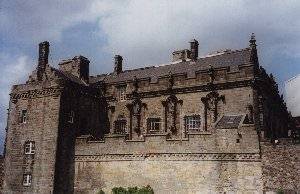| Where is Stirling Castle
Stirling is the most strategically important of all the
castles in Scotland. Hence it has been fought over and changed hands
more than any other Scottish castle. It is at the landward end of the
Firth of Forth, and controls movement across the Lowlands and into the
Highlands. He who controlled Stirling, effectively controlled Scotland
History of Stirling Castle
The Picts may have had a fort here, the Romans certainly
did. The Romans built their Fort on castle rock. It was later replaced
by a new castle commissioned by the Scottish King Alexander I, who died
at the Castle in 1124 and his body was taken to
Dunfermline for burial.
When William the Lion was captured by the English at Alnwick, he was
forced by Henry II to sign the Treaty of Falaise in 1174, which ensured
the six most important castles in Scotland, including Stirling, should
be garrisoned by English soldiers. In 1189 the castle was returned to
Scottish hands.
During the Wars of Independence Stirling really came into prominence
again. After capturing Berwick in 1296, Edward I of England took Stirling
Castle without a problem. But the next year the Scottish forces of William
Wallace, "Braveheart", beat the English army in battle
at Stirling Bridge.
Within a year it was back in English hands, but they soon had to surrender
to the Scots. In 1304 the castle was the last stronghold in the Scottish
rebels' hands and in April of that year King Edward I of England besieged
Stirling, who were forced to surrender when their food ran out.
The English then held Stirling until 1313, and following
Robert the Bruce's victory at Bannockburn, the Scots resumed control
of the castle. In fact Robert Bruce tried to destroy the fortifications
at Stirling to prevent it being used as an English garrison. But in
vain, as after defeating the Scots at Halidon Hill, the English returned
and strengthened the castle
1342 saw the English yielding in turn to the Scots.
And with the accession of the Stewarts as the Scottish Royal Family,
Stirling
once more became a Royal abode.
In 1452 Stirling was the site of the murder of William, 8th Earl of
Douglas by King James II. Douglas, had been invited to dine at the castle
under safe conduct from the King. The safe conduct was not respected,
and Douglas was slain
On the 9th of September 1543, the young Queen Mary (Mary Queen of Scots)
was crowned in the chapel royal at Stirling. In 1566 Stirling was once
again chosen as the refuge of a royal infant when the two month old
Prince James, son of Mary (later James VI) was moved there by feuding
Scottish lords.
In 1651, the Cromwellian General Monk, lay siege to Stirling and the
Governor was forced to surrender after a mutiny by his Scottish garrison.
After the restoration, the castle reverted to the Earl
of Mar and his heirs, but after the then Earl was accused of being a
Jacobite, King George I removed him from the castle
The Crown then was the keeper of Stirling Castle until
in 1923, when King George V restored it to the Earl of Mar. |
